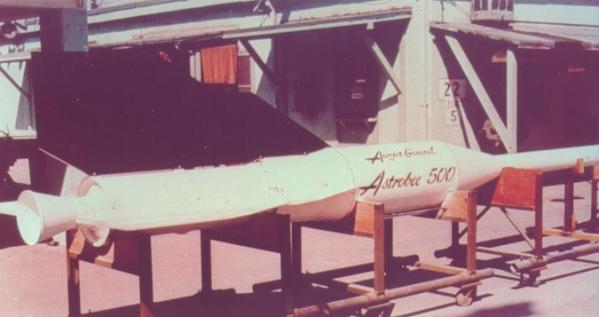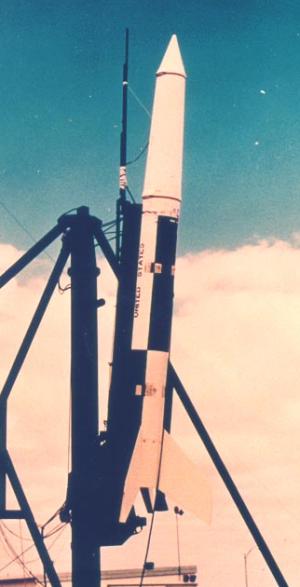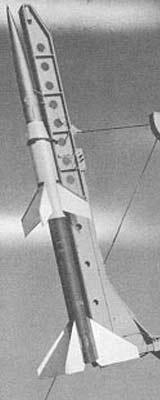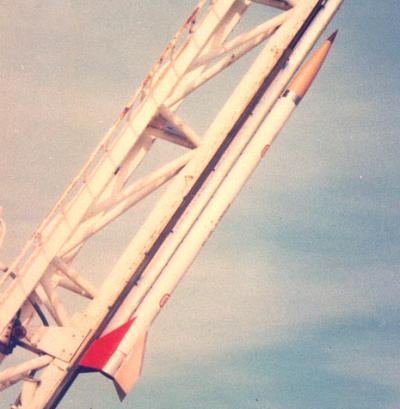Aerojet General Astrobee
(Models 200, 500, 1500, D, F)
In the late 1950s, solid-fueled sounding rockets had become viable competitors for Aerojet's proven line of liquid-fueled Aerobee models. The solid-fueled rockets, like the Nike-Deacon and Nike-Cajun, were cheaper to procure and simpler to operate then the Aerobees, and had a good enough performance for many applications. To re-establish its leading role as a manufacturer of sounding rockets for civilian and military research groups, Aerojet developed the Astrobee series of solid-propellant rockets.
Astrobee 500
The three-stage Astrobee 500 was the first model of the series, and was developed under contract from the AFCRL (Air Force Cambridge Research Laboratory). It was designed to lift an 18 kg (40 lb) payload to 965 km (600 miles) or 7 kg (15 lb) to 1230 km (765 miles) altitude. The rocket was fired from a rail launcher, and the Thiokol Genie first stage burned for around 2 seconds. After first stage separation, the vehicle coasted until it had passed most of the atmosphere, and then the Aerojet Alcor and Cooper Development Asp upper stages were successively ignited.
 |
| Photo: USAF |
| Astrobee 500 (less one fin) |
AFCRL ordered two Astrobee 500s. However, the first launch on 22 March 1960 failed for unspecified reasons, and the second rocket was apparently never fired.
Astrobee 1500
The two-stage Astrobee 1500 was the largest of the Astrobee series rockets. The first stage consisted of an Aerojet Junior motor and two Thiokol Recruit boosters. The cruciform fins were slightly canted to induce a stabilizing spin. A large clamshell nose fairing concealed the Aerojet Alcor second stage and the payload. The Alcor separated and ignited outside the atmosphere, and could lift the payload to more than 1600 km (1000 miles) altitude.
 |
| Photo: NASA |
| Astrobee 1500 |
The first Astrobee 1500 was launched by the USAF on 8 March 1961, followed by two others on 1 August (a failure) and 8 December that year. The latter rocket carried the unique Project Cambridge experiment, where a charge of high-explosive was detonated at 2190 km (1360 miles) altitude. The flash provided a reference point visible from both Hawaii and the U.S. mainland, enabling the scientists to measure the distance from Hawaii to the mainland with unprecedented precision. This ended the Air Force's use of the Astrobee 1500, but NASA launched another 7 rockets until October 1969.
Astrobee 200
The Astrobee 200 consisted of an M5 "Nike" booster and an Aerojet Alcor upper stage, and could reach an altitude of about 300 km (185 miles). It was exclusively used by the USAF's Air Force Cambridge Research Lab, which fired ten of these rockets between 30 June 1961 and 14 December 1966 with aeronomy and ionosphere experiments.
 |
| Photo: NASA |
| Astrobee 200 |
Astrobee D
In the late 1960, Aerojet proposed to develop a new family of solid-fueled sounding rockets, the Astrobee D, E and F (so named because they were designed to probe into the D-, E- and F-regions of the ionosphere, respectively). The Astrobee D was developed first, while the E was not built at all in the end.
 |
| Photo: Aerojet/WSMR, via Robert Biedron |
| Astrobee D |
The Astrobee D was a small single-stage vehicle powered by a dual-thrust (boost/sustain) rocket motor developed by Aerojet. With a typical payload of 15 kg (33 lb), it could reach an altitude of about 100 km (60 miles). The highest recorded apogee of the model was 129 km (80 miles). The first Astrobee D was launched on 8 June 1970, and a total of 42 examples were fired until February 1980. About half of these launches were conducted by the Air Force Cambridge Research Laboratory, which flew meteorology, aeronomy and plasma physics missions with the Astobee D until December 1975.
Astrobee F
The Astrobee F was designed as a solid-fueled replacement for the Aerobee 150. It had the same diameter and payload interfaces (allowing proven Aerobee payloads to be used without significant changes), and similar performance. The single-stage rocket was powered by a dual-thrust rocket motor, and could carry a payload of 90-230 kg (200-700 lb) to more than 200 km (125 miles) altitude.
 |
| Photo: Sven Knudson, Ninfinger Productions |
| Astrobee F |
The Astrobee F was primarily used by NASA, which launched 45 examples between 26 September 1972 and October 1981. However, the USAF also fired four Astrobee Fs, including the very last launch of that model on 2 March 1983.
Specifications
Note: Data given by several sources show slight variations. Figures given below may therefore be inaccurate!
Data for Astrobee 200/500/1500/D/F:
| Astrobee 200 | Astrobee 500 | |
|---|---|---|
| Length | 8.69 m (28 ft 6.1 in) | 7.77 m (25 ft 6 in) |
| Finspan | 1st stage: 2.48 m (8 ft 1.6 in) 2nd stage: 1.77 m (5 ft 9.8 in) |
1st stage: 1.83 m (6 ft) 2nd stage: 1.32 m (4 ft 4 in) |
| Diameter | 1st stage: 41.9 cm (16.5 in) 2nd stage: 52 cm (20.5 in) |
1st stage: 38 cm (15 in) 2nd stage: 51.6 cm (20.3 in) 3rd stage: 16.5 cm (6.5 in) |
| Weight * | 1220 kg (2690 lb) | 845 kg (1860 lb) |
| Altitude ** | 300 km (185 miles) | > 965 km (600 miles) |
| Propulsion † | 1st stage: ABL M5 Nike; 196 kN (44000 lb) for 3.5 s 2nd stage: Aerojet Alcor; 35.6 kN (8000 lb) for 30 s |
1st stage: Thiokol Genie; 161.3 kN (36250 lb) for 2 s 2nd stage: Aerojet Alcor; 35.6 kN (8000 lb) for 30 s 3rd stage: Cooper Devel. Asp; 26 kN (5850 lb) for 5.3 s |
| Astrobee 1500 | |
|---|---|
| Length | 10.56 m (34 ft 7.7 in) |
| Finspan | 3.02 m (9 ft 11 in) |
| Diameter | 79 cm (31 in) |
| Weight * | 5220 kg (11500 lb) |
| Altitude ** | > 1600 km (1000 miles) |
| Propulsion † | Booster: 2x Thiokol Recruit; 156 kN (35000 lb) each for 1.5 s 1st stage: Aerojet Junior; 254 kN (57000 lb) for 28 s 2nd stage: Aerojet Alcor; 35.6 kN (8000 lb) for 30 s |
| Astrobee D | Astrobee F | |
|---|---|---|
| Length | 4.02 m (13 ft 2.2 in) | 11.50 m (452.8 in) |
| Finspan | 0.61 m (2 ft) | 1.40 m (4 ft 7.2 in) |
| Diameter | 15 cm (6 in) | 38 cm (15 in) |
| Weight * | 100 kg (220 lb) | 1375 kg (3030 lb) |
| Altitude ** | > 100 km (62 miles) | > 200 km (125 miles) |
| Propulsion † | Aerojet dual-thrust rocket; 23 kN (5200 lb) / 8.9 kN (2000 lb) for 17.5 s total |
Aerojet dual-thrust rocket; 178 kN (40000 lb) for 3.9 s + 36.4 kN (8180 lb) for 51.1 s |
** With typical payloads
† All stages are solid-propellant rockets
Main Sources
[1] Peter Alway: "Rockets of the World", Saturn Press, 1999
[2] Peter Alway: "Rockets of the World, 2000 Supplement", Saturn Press, 2000
[3] Mark Wade: Encyclopedia Astronautica
[4] Jonathan McDowell: Launch Vehicles Database
[5] Sounding Rocket Study of Eighteen Vehicles,
Summary Report, Vought Astronautics for NASA Langley Research Center, April 1961
Back to Directory of U.S. Military Rockets and Missiles, Appendix 4
Last Updated: 13 July 2004